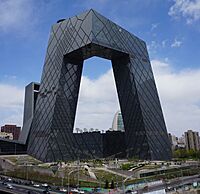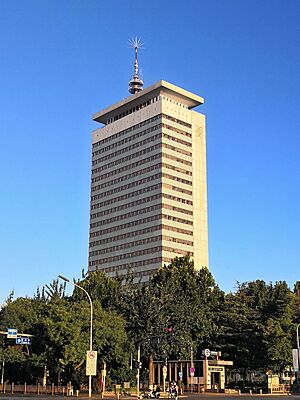China Central Television facts for kids
 |
|

The China Central Television Headquarters in 2019
|
|
| Type | State media |
|---|---|
| Country | China |
| First air date | 1 May 1958 |
| Founded | Beijing |
| Headquarters | CCTV Headquarters, Beijing, People's Republic of China |
| Broadcast area | Worldwide |
| Parent | China Media Group |
| Former names | Beijing Television |
| Free channels | 25 |
| Pay channels | 19 |
| Callsigns | Voice of China (external) |
| Affiliation | China Global Television Network |
| China Central Television | |||||||||||||||
|---|---|---|---|---|---|---|---|---|---|---|---|---|---|---|---|
| Simplified Chinese | 中国中央电视台 | ||||||||||||||
| Traditional Chinese | 中國中央電視台 | ||||||||||||||
| Literal meaning | China Central Television Station | ||||||||||||||
|
|||||||||||||||
| Chinese abbreviation | |||||||||||||||
| Simplified Chinese | 中央电视台 | ||||||||||||||
| Traditional Chinese | 中央電視台 | ||||||||||||||
| Literal meaning | Central Television Station | ||||||||||||||
|
|||||||||||||||
| Second alternative Chinese name | |||||||||||||||
| Simplified Chinese | 央视 | ||||||||||||||
| Traditional Chinese | 央視 | ||||||||||||||
| Literal meaning | Central-Vision | ||||||||||||||
|
|||||||||||||||
China Central Television (CCTV) is the main television broadcaster for China. It started in 1958 and is managed by the National Radio and Television Administration. This administration reports to a part of the Chinese government.
CCTV has many important jobs. It shares news, helps educate people, and provides cultural and entertainment programs. It plays a big role in how the Chinese government shares information with its citizens. Some groups have noted that CCTV's news reports on topics important to the Chinese government are carefully controlled.
Contents
History of CCTV
Early Days of Television in China
In 1954, Mao Zedong, who was the leader of the Chinese Communist Party, suggested that China should have its own TV station. By 1955, plans were made to create a medium-sized television station. Zhou Enlai, a top leader, included the idea of starting TV broadcasts in China's first five-year plan.
In December 1957, two people, Luo Donghe and Meng Qiyu, visited TV stations in the Soviet Union and East Germany. They then returned to Beijing to get ready for China's own station. The station officially began broadcasting on May 1, 1958. It was first known as Beijing Television.
Becoming China Central Television
On May 1, 1978, Beijing Television officially changed its name to China Central Television. This happened just in time for its 20th anniversary. A new logo was also introduced.
Until the late 1970s, CCTV only broadcast programs in the evenings. It usually stopped broadcasting around midnight. During school holidays, it sometimes showed programs during the day for students. Special daytime shows were also aired on national holidays.
Growth and International Reach
In 1980, CCTV started trying out new ways to send news from local and central TV studios using microwave technology. That same year, it worked with NHK, a public broadcasting company from Japan. They created a documentary series called Silk Road.
By 1985, CCTV had become a very important television network in China. In 1987, CCTV became even more popular because of its TV drama Dream of the Red Chamber. This was the first Chinese TV drama to be shown around the world. In the same year, CCTV sent over 10,000 shows to 77 TV stations in other countries.
In the 1990s, CCTV started using new rules for its programs. These rules focused on whether programs were affordable to buy and acceptable in their content. This meant programs needed to be suitable and not go against the government's views.
In March 2018, CCTV became part of a new state-owned group called the China Media Group. This was part of a larger plan to improve government organizations.
Broadcasting Around the World
In 1990, a company connected to CCTV, called CITVC, started China Television Corporation in California. This helped share CCTV content in the United States. In 2000, CCTV launched its first all-English channel, known as CCTV-9 or CCTV International.
In 2001, a plan was started to help China's voice be heard more around the world. CCTV-9 became the first 24-hour English channel, aiming to reach audiences overseas. In October 2001, CCTV worked with other foreign news companies. This allowed them to show their programs in China in exchange for CCTV-9 programs being shown in the US and Europe.
On April 1, 2007, the CCTV-4 channel split into three separate channels. Each channel served a different time zone: China Standard Time, Greenwich Mean Time, and Eastern Standard Time. This helped improve service for viewers worldwide.
On July 25, 2009, CCTV launched its Arabic-language international channel. This channel aimed to build stronger connections with Arab nations.
In December 2016, CCTV's foreign language services became a new network called China Global Television Network (CGTN). CCTV also works with other countries, like Uzbekistan, to create joint programs and documentaries.
China Network Television
China Network Television (CNTV) was an online broadcasting service for China Central Television. It started on December 28, 2009.
How CCTV is Organized
CCTV is part of the China Media Group (CMG). It is overseen by the National Radio and Television Administration, which is connected to the Chinese government. CCTV is considered one of the three biggest state media organizations in China, along with the People's Daily newspaper and Xinhua News Agency.
CCTV Leadership
The current president of CCTV is Shen Haixiong. He was appointed in February 2018. He also holds a leadership position within the Chinese government.
CCTV Programs
CCTV creates its own news programs three times a day. It is the most powerful and active producer of television programs in China. Its main evening news show, Xinwen Lianbo (which means "CCTV Network News"), airs every day at 7:00 PM Beijing time. All local TV stations in China are required to show this news broadcast. A survey by CCTV showed that almost 500 million people across the country regularly watch this program.
Focus Report (jiaodian fangtan) was a popular CCTV show that started in 1994. It often showed problems caused by local officials, which got serious attention from higher levels of government. It also showed how the Chinese government responded to accusations of problems.
The CCTV New Year's Gala is a special program shown every year for the Chinese New Year. It is the most-watched show on CCTV.
In 2003, CCTV launched its first 24-hour news channel. This channel was first available to people who had cable TV.
CCTV Channels
Audience Numbers
As of 2007, about 1.2 billion people in China watched television. With more types of content available, CCTV sometimes faces competition from cable, satellite, and local TV networks. For example, in some cities, local stations have more viewers than CCTV. However, the CCTV New Year's Gala is still extremely popular. More than 90% of the country watches it.
CCTV Personalities
China Central Television has many different hosts, news anchors, reporters, and people who contribute to its daily programs.
- Ai Hua
- Bai Yansong
- Bao Xiaofeng
- Daniela Anahí Bessia
- Bi Fujian
- Chai Jing
- Chai Lu
- Chen Yin
- Dashan
- Dong Hao
- Dong Qing
- Marc Edwards
- Gao Bo
- Gang Qiang
- Guo Zhijian
- Hai Xia
- He Jing
- Jing Yidan
- Ju Ping
- Vimbayi Kajese
- Kang Hui
- Michele Lean
- Li Ruiying
- Li Sisi
- Li Xiaomeng
- Li Yong
- Li Zimeng
- Liu Chunyan
- Lu Jian
- Edwin Maher
- Ouyang Xiadan
- Negmat Rahman
- Ren Luyu
- Rui Chenggang
- Sa Beining
- Wang Ning
- Wang Xiaoya
- Wang Zhi'an
- Zhang Hongmin
- Zhang Mengmeng
- Zhang Tengyue
- Zhou Tao
- Zhu Jun
- Zhu Xun
See also
 In Spanish: Televisión Central de China para niños
In Spanish: Televisión Central de China para niños
- Mass media in China
- Television in the People's Republic of China



